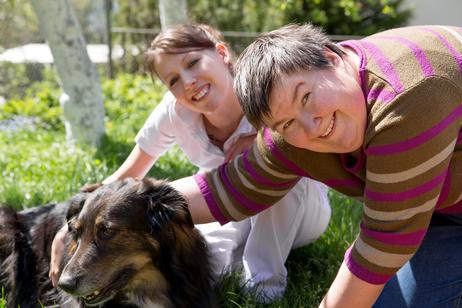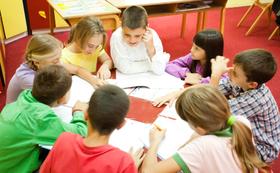There is a special bond between children and their dogs but, for some children, a dog is more than just a best friend – he is an assistant for everyday tasks. Children with certain diseases and disabilities sometimes need the help of a service dog just to get through their day. The service dog accompanies them everywhere they go – even to school. While a service dog may be a necessity for the student he serves, it is possible he could become a distraction for other students. But where do you draw the line?
In today’s modern society, distractions are everywhere. Cell phones and tablets are being given to younger and younger children as society as a whole becomes progressively more reliant on technology. But what determines whether something is too distracting? When it comes to service dogs, there are some legitimate concerns regarding allergies and fears that some students may have, but are these concerns more legitimate than the student’s need for the service dog? Keep reading to learn more about this issue.
What Exactly Do Service Dogs Do?
According to the Americans with Disabilities Act (ADA), the definition of a service animal is, “any dog that is individually trained to do work or perform tasks for the benefit of an individual with a disability, including a physical, sensory, psychiatric, intellectual, or other mental disability”. Some of the tasks a service dog can perform might include pulling a wheelchair, picking up dropped items, reminding someone to take their medications, providing emotional support and comfort, or alerting the individual to a sound or condition. For example, service dogs can be trained to detect low blood sugar in diabetics or to predict seizures in individuals with epilepsy.
Depending on the type of service a service dog provides, it may be called different things. Here are the definitions of various types of service animals according to the ADA:
- Seeing Eye Dog (or Guide Dog) – This type of service dog is trained as a travel tool for individuals who are blind or who have visual impairments. The dog helps the individual to get around.
- Signal Dog or Hearing Dog – This service dog is used by individuals who are deaf or who have significant hearing loss. The dog is trained to alert the person when a sound occurs, like the ringing of the doorbell.
- Psychiatric Service Dog – This type of service dog is trained to detect the onset of psychiatric episodes and to help lessen their effects. Services performed by these dogs may include reminding the individual to take medication, providing room searches or safety checks, turning on the lights, protecting disoriented individuals from harm, or disrupting self-mutilation.
- SSigDOG (Sensory Signal Dog) – This type of service dog is specifically trained to assist a person with autism. These dogs help to alert the individual to distracting repetitive movements such as hand flapping.
- Seizure Response Dog – These dogs are trained to help people with seizure disorders by standing guard over the person during a seizure or by going for help. Some dogs can even predict seizures and warn the individual to sit down or to find a safe place.
Service dogs can be trained for a wide variety of services and each dog is trained to work with a specific individual. It can take weeks of training for an individual and a service dog to learn how to work together. A service dog is more than just a pet – it is a necessity for the person he serves.
This video offers an overview of a service animal in school.
Should Service Dogs Be Allowed in the Classroom?
Everyone loves a heartwarming story about a child and his service dog, but when it comes to service dogs in schools, not all of the stories are happy ones. In fact, some school districts completely refuse to allow students to bring their service animals to school, despite the fact that this is in violation of both state and federal law. Some school districts have even gone so far as to demand a court order for individuals to be allowed to bring their service dogs to school. But why are some schools so against service dogs in the classroom? Here are a few arguments that schools like this sometimes make:
- A dog could be a safety risk for other students.
- Some students may be afraid of or allergic to dogs.
- The school staff hasn’t been trained to handle a service dog.
- Students and faculty could be distracted by the dog.
Though some of these concerns are understandable, none of them have been known to hold up in a court of law. The idea that a service dog might harm a student or teacher is blatantly ridiculous. Service dogs are chosen for their gentle temperament and any dog that bitten someone would never be certified. For students who are afraid of or allergic to dogs, there are ways to work around the issue. Lack of training is also not a problem because any service dog that accompanies a child to school will also likely be accompanied by a handler. Finally, there are plenty of distractions for students and a dog is no more distracting than any of them. He might be a novelty at first but eventually, the interest will wear off and students won’t even notice he’s there.
This video captures the first day at school with service dogs.
Basic Classroom Etiquette for Service Dogs
The most important thing you need to realize about service dogs is that they are not (just) a pet – they are a therapy animal and they have a job to do. As the parent of a child who requires a service dog, you already understand that but it is part of your job to make sure that educators and school board members at your child’s school understand the same. You may also need to help teach students and teachers about proper etiquette for being around service dogs. Here are some useful points to touch on:
- Do not engage with a service dog while he is working – just because the dog is at rest doesn’t mean he isn’t still on the job.
- Do not talk to the dog, make eye contact, or try to distract the dog from his job – only the dog’s handler should be issuing commands.
- Don’t offer a service dog any foodservice dogs are kept on strict schedules for food and water and they generally aren’t allowed “people food”.
- Be mindful about interacting with the dog’s handler – don’t distract him from his job or create a stumbling block that might make his job more difficult.
This video reports on service dogs in high school.
If your child requires a service dog, it is your job to deal with any challenges that arise when it comes to taking the dog to school. It is very important that you engage in an open dialogue with school officials to make sure they understand that the dog is a necessity and be open to compromises and workarounds as needed. Your child’s education is just as important as anyone else’s so he should be allowed to bring his service dog to school if it is necessary, but you should take steps to make sure that it doesn’t become a stumbling block for other students in pursuit of their own education.
Questions? Contact us on Facebook. @publicschoolreview















